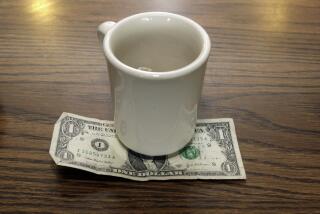BITES : No More Mr. Nice Guy
- Share via
Have you heard about the waitress who got a $1,140 tip only to have the customer try to renege on it three months later?
Last November, Ruth Bullis was working a lunch shift at Stanford’s restaurant in Lake Oswego, Ore. A customer put a $40 tip on his credit card; she thanked him profusely. He asked her the largest tip she’d ever gotten, which was $100 (for a party of 15), and when he paid for his next drink, she found he’d put down a $100 tip.
For his last drink--his fourth--he put down a $1,000 tip. She protested that it was too much, but he told her she’d need the money if she and her husband were going to start a family. Bullis thinks he may have overheard her talking with the bartender about her family plans.
Three weeks later the same guy, a lumber broker in his early 50s, showed up at the same table, told Bullis he’d thought of her when he paid his credit card bill and left another $100 tip. Bullis, who’d put the earlier tips aside in case the customer had second thoughts, decided it was safe to spend the money.
Then in February, the credit card company informed the restaurant that the customer was disputing the bill and wanted his money back. After the story started appearing in newspapers, the restaurant was besieged by calls from cable news shows and radio talk shows all over the country.
So what’s the upshot? “It’s been 60 days, and we haven’t heard anything more from him or American Express,” manager Steve Saunderson told The Times last week. “I think he’s probably digging a hole to bury himself in. It’s too bad. He was a regular customer.”
The Juice
Mademoiselle is debunking some health food reputations. Honey is just sugar, say the dietitians the magazine consulted, half a cup of granola has the fat content of a McDonald’s hamburger, rice cakes have minimal nutrition and wheat grass juice “has no nutritional value to humans.”
So probably that goes double for wheat grass juice lite, huh?
What’s Blue, Purple and Pink Nearly All Over?
Easter Sunday may smell of flowers, chocolate and Easter dinner, but the house smells of vinegar for the day or two before as people use the stuff to set Easter egg dyes. People often put a bit of vinegar in the cooking water as well to make the eggs less likely to crack. The Easter season registers the year’s peak sales for both eggs and vinegar.
As for peaks, Heinz Vinegar reports that the most popular Easter egg color is blue--36% of the nation’s eggs wind up that color--with purple and pink tying for second at 17% each. All the other colors have to divvy up the remaining 30% of eggs.
Apparently, the least common egg dye colors are white and brown. We wonder why. Oops, forget that--we just figured it out.
Hey, Collect ‘Em All!
Wine labels have long offered serving suggestions, usually “goes with pasta, seafood and the lighter meats.” Dunnewood Vineyards gets a lot more specific. Peel off the top layer of the back label on one of its wines and you’ll find a simple recipe by the winery’s culinary counselor, Rozanne Gold. Examples: filet of beef with Gorgonzola whipped potatoes (goes with Cabernet Sauvignon), roast pork tenderloin with prunes and bay leaves (that one’s got “Merlot” written all over it).
More to Read
Eat your way across L.A.
Get our weekly Tasting Notes newsletter for reviews, news and more.
You may occasionally receive promotional content from the Los Angeles Times.









